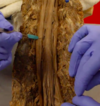Vertebral Column and Contents Practical Flashcards
(71 cards)
What are some ‘red flags’ for backpain?
-
Cauda equina syndrome:
- Severe or progressive bilateral neurological deficit of the legs
- Recent-onset urinary retention and/or urinary incontinence
- Recent-onset faecal incontinence
- Perianal or perineal sensory loss (saddle anaesthesia or paraesthesia).
-
Spinal Fracture:
- Sudden onset of severe central spinal pain which is relieved by lying down.
- A history of major trauma minor trauma, or even just strenuous lifting in people with osteoporosis or those who use corticosteroids.
- Structural deformity of the spine
-
Cancer:
- Gradual onset of symptoms.
- Weight loss
How mayn cervical vertebrae do adults typically have?
7
How many cervical spinal nerves are there?
8 pairs of spinal nerves
How many thoracic vertebrae are there?
12
How many vertebrae are fused together to form the sacrum?
5
How many vertebae are fused together to form the coccyx?
4
The spinal cord typically ends at which vertebral level?
L1-L2
Below which vertebrae should you do a lumbar puncture?
Below L3
Where are the 2 lordosis’ located?
Cervical and lumbar regions
Where are the 2 kyphosis’ located?
Thoracic and sacral regions
Which region is each vertebrae taken from?

- Thoracic –> furthest left
- Cervical –> furthest right
- Bifid spinous process
- Foramina in the transverse processes
- Lumbar –> middle
- Thick, large vertebral body
- Short, stumpy spinous process
Label:
- A
- B
- C
- D
- E
- F
- A: vertebral body
- B: pedicle
- C: transverse process
- D: superior articular facet
- E: lamina
- F: spinous process
From left to right; cervical, thoracic and lumbar vertebrae
- Cervical:
- Smaller vertebrae –> more flexible
- Lumbar:
- Large vertebral body due to weight-bearing

Typical features of vertebrae?

- Vertebral body - lies anteriorly
- Vertebral arch behind the body
-
Vertebral foramen enclosed between body and arch
- Spinal canal which houses the cord/spinal nerves
-
Pedicles
- Connect the arch to the body
- Vertebral arch has many bony projections
- 2 transverse processes; posterolateral
-
Laminae
- These come together to form a single, midline posterior spinous process
-
Superior articular processes and facets
- For articulation with vertebrae above –> forms facet joints
- Inferior articular processes and facets

What is the pedicle of the vertebrae?
Two pedicles extend from the sides of the vertebral body to join the body to the arch –> a stub of bone that connects the lamina to the vertebral body to form the vertebral arch.

What is the lamina of the vertebrae?
The lamina of the vertebral arch are two broad plates, extending dorsally and medially from the pedicles, fusing to complete the roof of the vertebral arch. The 2 laminae come together to form the spinous process.

What is the superior and inferior articular processes and facets?
- A superior articular process extends or faces upward, and an inferior articular process faces or projects downward on each side of a vertebrae
- The paired superior articular processes of one vertebra join with the corresponding paired inferior articular processes from the vertebra above (via the facets)

What 7 processes arise from the vertebral arch?
- Each paired transverse process projects laterally and arises from the junction point between the pedicle and lamina.
- The single spinous process projects posteriorly at the midline of the back.
- A superior articular process extends or faces upward on each side of a vertebrae
- An inferior articular process faces or projects downward on each side of a vertebrae.

How do the cervical vertebrae differ?
- A small body
- Usually have a bifid spinous process
- The spinous processes of the C3–C6 vertebrae are short, but the spine of C7 is much longer.
- Prominent C7 spine located at the base of the neck
- The spinous processes of the C3–C6 vertebrae are short, but the spine of C7 is much longer.
- The transverse processes of the cervical vertebrae are sharply curved (U-shaped) to allow for passage of the cervical spinal nerves.
- Each transverse process also has an opening called the transverse foramen.

How do the thoracic vertebrae differ?
- 2 costal demi facets on either side of vertebral body for articulation with head of rib
- Superior costal facet articulates with head of rib above
- Inferior costal facet articulates with head of corresponding rib
- Presence of costal facets on the transverse process for articulation with the tubercles of the ribs

Compare the spinous process of:
- Cervical spine
- Thoracic spine
- Lumbar spine
- Cervical:
- Typically bifid
- Typically short except when you get to C6 and C7
- Projects out horizontally
- Thoracic:
- Typically long
- Projects out obliquely, meaning it overlaps the spinous process of the vertebra below
- Lumbar:
- Short but think
- Spinous process projects out horizontally

What is the vertebra prominens?
The name of the seventh cervical vertebra –> the long and prominent spinous process is palpable from the skin surface
How does the vertebral foramen vary between the:
- cervical spine?
- thoracic spine?
- lumbar spine?
- cervical:
- triangular shape
- relatively large vertebral foramen
- thoracic:
- rounded shape
- lumbar:
- triangular shape
- relatively small

What is benefit of relatively large vertebral foramen in cervical spine?
Gives spinal cord ‘wiggle room’ –> cervical injuries don’t always result in spinal cord damage
































